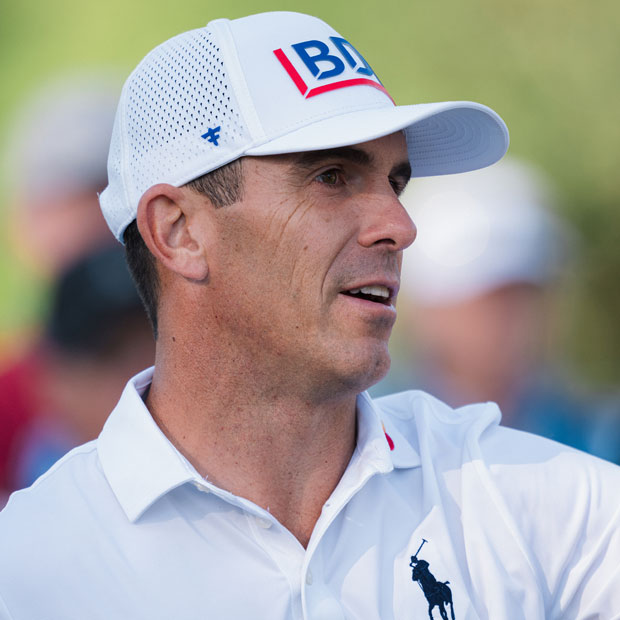Jonathan’s Landing Golf Club (Match Course at Old Trail)
The Match Course at Old Trail, a Gil Hanse-led reimagining of an Arthur Hills design, seeks to bring a match play culture to Jonathan’s Landing Golf Club

Jupiter, Florida, USA
Arthur Hills (original design, 1991); Hanse Golf Course Design (redesign, 2021)
Private
As the name suggests, Jonathan’s Landing Golf Club, in reimagining its Arthur Hills-designed Hills Course at Old Trail, drew inspiration from Gil Hanse’s work at Ohoopee Match Club and sought to bring a match play culture to its South Florida facility. The resulting course tops out at a sporty 6,500 yards from the back plates—similar to Ohoopee’s afternoon “Whiskey Routing”. There are no formalized tee boxes, allowing whoever wins the previous hole to pick the next teeing location. Completed during the Covid era, the Match Course represented the start of a remarkable surge of new construction and renovation work in the West Palm Beach area.
{{content-block-course-profile-jonathans-landing-match-at-old-trail-001}}
Take Note…
Three courses, two locations, lots of architects. The Match Course is one of a trio of courses under the Jonathan’s Landing banner. The club operates a town clubhouse in Jupiter, near the Village Course, which was designed by George Fazio in 1978, reworked by Tom Fazio in 2000, and will soon be reworked again by Beau Welling. The Old Trail facility is 20 minutes west of the Village Course and is devoted strictly to golf. This is where you’ll find the Match Course, along with the Medal Course, a Tom Fazio design recently redone by Kipp Schulties.
Pards. Gil Hanse’s design partner Jim Wagner moved to South Florida from Philadelphia in 2014, and the firm has begun to make major inroads in the region. In addition to the Match Course, Hanse and Wagner built The Park, a municipal course in West Palm Beach, and the West Course at Apogee Club, the first course at the new high-end private facility in Martin County. Both opened last year.
Tee tip. There’s a hidden tee box right off the ninth green for the 10th hole. It’s way more enjoyable to play from there than to walk back to the more commonly used teeing grounds.
Favorite Hole
No. 2, par 5, 530 yards
This striking par 5 makes excellent use of a large water hazard along its right side. The tee shot invites players to take on as much risk as they want in order to shorten the hole and gain a better angle for the second shot.
Favorite Hole
No. 2, par 5, 530 yards
This striking par 5 makes excellent use of a large water hazard along its right side. The tee shot invites players to take on as much risk as they want in order to shorten the hole and gain a better angle for the second shot.
I particularly like how the hole creates consequences for bailing out left. In the landing zone on the left, there is a wide, deep, penal fairway bunker that captures any tee shot hedging too far away from the hazard. Sure, your ball could miss this bunker, or you could play short of it, but finding it or laying up behind it turns this short par 5 as a certain three-shot hole.
The right side of the fairway, on the other hand, opens up the green and makes attempts to reach in two much easier. Of course, it comes with the threat of a water ball.

{{content-block-course-profile-jonathans-landing-match-at-old-trail-002}}
Overall Thoughts
Many golf courses will soon find themselves exactly where Jonathan’s Landing was in 2018. The club’s 1991 Arthur Hills design had fallen behind trends in golf architecture trends, and it simply looked and felt tired. At this crossroads, the decision-makers at Jonathan’s Landing had a couple of different options. They could renovate the Hills design, giving it new infrastructure but leaving the design intact, or they could blow it up and start over. They opted to take the big swing. They hired Gil Hanse and Jim Wagner to redesign the Hills course, taking advantage of Wagner’s residence in South Florida for the increased attention that comes with a “home game.”
To give you an idea of Wagner’s approach to the project, he told me on a 2021 episode of the Fried Egg Golf Podcast that his key was “to pretend the old golf course [wasn’t] there.”
The firm sought to rid the course of what Wagner calls “Florida golf,” which he defines pithily as “houses and water.” The Old Trail property has the benefit of not being surrounded by houses, but the Hills design featured water hazards on many holes. The club allowed Hanse and Wagner to move the borders of the water hazards as long as they maintained the same overall square footage of water storage. So the architects attempted to move as much water as possible toward the perimeter of the property. By doing this, Hanse and Wagner were able to limit the number of holes that would play along water. If a water hazard is on the edge of a site instead of toward the center, it will come into play on only one hole as opposed two or more.
{{content-block-course-profile-jonathans-landing-match-at-old-trail-003}}
Another effect of this change is that the small, U-shaped property feels a lot bigger. The Match Course’s footprint, including the lakes, is a mere 80 acres. With the water away from the middle, Hanse and Wagner could create a few broad playing areas with long views across golf holes. As a result, the property feels less cramped than it did when ponds continually pinched the playing corridors. The joined fairways also introduce a strategic element: you can play down different corridors for angles into certain pins (though this might create some safety problems…).
Like many Arthur Hills designs from the 1980s and 90s, his Old Trail course featured containment mounding. This repetitive and unartistic type of shaping is usually found bordering fairways, blocking the views of neighboring holes. Hanse and Wagner eliminated most of the containment mounds on the Match Course property but retained a few—as central strategic features. For example, the par-3 16th hole has a collection of mounds obscuring the view of the front of the green. Those mounds used to be on the perimeter of another hole.
As a complement to the open playing corridors, Hanse and Wagner built a fun, varied set of greens. The most memorable ones—including the punchbowl third, the long and narrow fourth, the pear-shaped seventh, and the pushed-up 13th—have bold contours that can cause swings in matches by rewarding great shots and forcing tough two-putts after merely average shots.
The match-play concept of the project also seems to have energized Hanse and Wagner to experiment with bunker shaping. Some of the Match Course’s gnarlier bunkers have a severity that might rub the scorecard-and-pencil police the wrong way.
All in all, Hanse and Wagner’s work is worthy of study. They transformed a flat piece of “Florida golf,” littered with ponds and containment mounds and mundane design, into a compelling and unique course. When the course opened, it was unlike any other in the area—devoid of formal tee boxes, maxing out at 6,500 yards, and meant for match play only. There are a few remaining signs of Florida-style target golf, such as the tight, OB-right-water-left fifth hole and the claustrophobic water-right-water-left second shot on No. 10. For the most part, however, Hanse and Wagner pulled off the feat of transforming a nothingburger into a something-burger.
There was a problem, though. The members need to buy in.
Fast-forward to a year after opening, and the Match Course at Old trail has a different vibe. There are five sets of formal tee boxes and scorecards with all of the yardages. This simple change diminishes the course. Since it tips out at 6,500, many players will go straight to the back tees, accentuating some backwards walks that aren’t mandatory if you play a “winner of the previous hole picks the next tee” match. The course now routinely hosts stroke-play events for the club.
Simply put, the Jonathan’s Landing membership violated the original Hanse-Wagner concept by bringing back some of the conventions of South Florida golf. This is obviously their right; they funded the redesign, after all. But it’s a reminder that for a match-play concept to work, the club has to be fully committed from the get-go. Redesigns are hard, not least because members already spent a lot of money to join the previous version of the club. They liked that club! And the core message of a big redesign is that the course they liked actually stunk. That’s not easy to accept.
The Match Course is an interesting, well-executed work of golf architecture. But it’s also proof that changing the culture of an existing club is harder than establishing a new culture with a new design like Ohoopee Match Club.
0 Eggs
The Match Course represents a fun, unusual model for club golf. Unfortunately, Jonathan’s Landing is not presenting the course in the fashion that Gil Hanse and Jim Wagner built it. With the loss of flexible teeing locations and match-play spirit, the design suffers. In theory, players could act as though the teeing areas were still freeform—but that’s just theory. In practice, there’s a lot of stroke-play happening out there. If the club were to return to the no-tee-box concept—or even just have one or two sets for medal play—then we could talk about giving the Match Course one Egg.
Course tour

{{content-block-course-profile-jonathans-landing-match-at-old-trail-004}}
Leave a comment or start a discussion
Get full access to exclusive benefits from Fried Egg Golf
- Member-only content
- Community discussions forums
- Member-only experiences and early access to events















Leave a comment or start a discussion
Lorem ipsum dolor sit amet, consectetur adipiscing elit. Suspendisse varius enim in eros elementum tristique. Duis cursus, mi quis viverra ornare, eros dolor interdum nulla, ut commodo diam libero vitae erat. Aenean faucibus nibh et justo cursus id rutrum lorem imperdiet. Nunc ut sem vitae risus tristique posuere. uis cursus, mi quis viverra ornare, eros dolor interdum nulla, ut commodo diam libero vitae erat. Aenean faucibus nibh et justo cursus id rutrum lorem imperdiet. Nunc ut sem vitae risus tristique posuere.